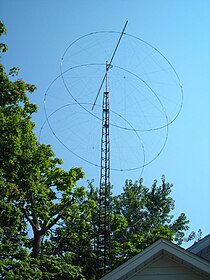User:N8ppq/Sandbox
| This user page may require cleanup to meet Wikipedia's quality standards. No cleanup reason has been specified. Please help improve this user page if you can; the talk page may contain suggestions. |

The Quad antenna is an antenna which is frequently used by amateur radio operators. It consists of a driven element and parasitic elements, like a Yagi; however, the elements are square loops. If there is only one parasitic element it is referred to as a 'Cubical Quad' (since it will be an approximate cube).
It was developed by Clarence C. Moore (patent no. 2,537,191), W9LZX, an engineer at HCJB (a shortwave missionary radio station high in the Andean Mountains). He developed it to resolve issues with large coronal discharges in the thin air with a beam antenna.
Moore describes his antenna as "a pulled-open folded dipole" and describes the time when it was developed:
| “ | We took about one hundred pounds of engineering reference books with us on our short vacation to Posoraja, Ecuador during the summer of 1942, determined that with the help of God we could solve our problem. There on the floor of our bamboo cottage we spread open all the reference books we had brought with us and worked for hours on basic antenna design. Our prayers must have been answered, for gradually as we worked the vision of a quad-shaped antenna gradually grew with the new concept of a loop antenna having no ends to the elements, and combining relatively high transmitting impedance and high gain. | ” |
Moore's design eliminated coronal discharge. "End effect", which is inherent with the Yagi, is absent in a quad because its elements have no ends. But other advantages appeared. The higher impedance, mentioned in the quote above, translates to lower current and thus lower loss on the transmission lines. And gain was found to be higher than that of a Yagi.

Rigorous testing of the quad antenna, reported in William Orr's authoritative "All About Cubical Quad Antennas", and others, have illustrated the following advantages over a Yagi antenna.
• Higher Gain
The 2-element Quad has almost the same gain as a 3-element Yagi: about 7.5 dB over a dipole. Likewise, a 3-element Quad has more gain than a 3-element Yagi. However, adding quad elements produces diminishing returns. Quoting from William Orr,
"Whereas parasitic beams having twenty or thirty parasitic directors are efficient, high gain antennas, it would seem... that maximum practical number of parasitic loop elements for the Quad array is limited to four of five." (Orr, Pg. 48)
• Radiation Resistance approximately 50Ω
Radiation resistance is affected by antenna height above ground, element spacing, and environmental conditions. However, values will be higher than Yagi's and more closely matched to a 50 Ω coaxial feed line.
• Lower Boom Height
"A two-element, three-band quad, with elements mounted only 35 feet above ground, will give good performance in situations where a triband Yagi will not." (Page 12-3 of the 15th edition of The ARRL Antenna Book.)
• Shorter Boom
William Orr's book shows a 10-15-20 meter, 2-element Quad with boom length of 6'10".
• May be Internally Stacked to form Multi-Band Arrays
As Orr states, interaction between antennas of a multi-band Quad are quite low, even when fed with a single feed line. (Orr, Pg. 63)
• Lower Angle Radiation
According to K0SR, (pg. 5 of the ARRL's Jan/Feb 2008 National Contest Journal) the claim that quads "open the band earlier", which suggests that they exhibit a lower angle of radiation than Yagis, has persisted for 50 years in spite of the fact that computer models disagree. He posits that the vertical sides of each element actually radiate the low angle component.
• Broader Bandwidth
The bandwidth for a 3-element Quad antenna that is tuned for maximum gain is limited because excursions from the design frequency unbalance the near resonance condition of the parasitic elements. However, by lengthening the reflector and director elements, thus sacrificing approximately 1 dB gain, the entire 10 meter band may be worked with an SWR below 1.75:1.
• Quieter to RF Noise
This is an unsubstantiated, subjective note.
The E-Z-O Antenna
[edit]
An improvement over the Quad design has been claimed by N8PPQ. In 2008 he introduced the E-Z-O antenna which uses flexible dielectric tubes, rather than rigid poles, to support the electrical elements. He claims slightly higher gain over the Quad due to its circular form; circles being the shape that the Quad only roughly approximates. Here is his list of reported improvements over the Quad antenna:
♥ Lower Cost
♥ Higher Gain
♥ Lighter in Weight
♥ Less Wind/Ice Loading
♥ Easier to Install and Maintain
♥ Esthetically Pleasing
The magnitude of the dielectric effect on the outside band elements was surprising. Experimentation was required to establish optimum element lengths. Referencing literature was not to be found. As reported at http://personal.ee.surrey.ac.uk/Personal/D.Jefferies/antennexarticles/diecon.htm, "As far as we are aware, there has been no reported work on encasing loop antennas in dielectric." It appears that "near field" interaction between parallel components increases the effect of the dielectric. Near field analysis is too complicated for this author.
Patents
[edit]References
[edit]- All about Cubical Quad Antennas by William I. Orr
Category:Radio frequency antenna types
de:Quadantenne fr:Antenne quad nl:Quad (antenne)
